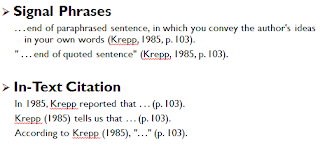INTRODUCTION
TO SYNTHESIS
Actually, synthesis is one of the steps of BIG6 process and
there are lots of definitions of synthesis. However, I realized that 2 main
points in synthesizing is that organizing and presenting information. It is
really helpful to help students to see how readers monitor overall meaning,
important concepts, and themes as they read, understanding that their thinking
evolves in the process.
TOOLS FOR PRESENTING INFORMATION
Probably, to get easy in presenting information; firstly we need to organizing into simple summary because it is a strategy that allows us to categorize and classify the information gathered as readers, sorting out significant ideas, events, and other pieces of information.
Probably, to get easy in presenting information; firstly we need to organizing into simple summary because it is a strategy that allows us to categorize and classify the information gathered as readers, sorting out significant ideas, events, and other pieces of information.
Moreover, when reading a long piece, we needs to pause and
regroup every so often, making notes as necessary.
Summarizing and synthesizing:
- Summarizing is identifying key points and organizing thoughts, a listing of the parts. Summarizing usually occurs at the end.
- Synthesizing is the creation of a whole. It goes on throughout the process of reading—not just at the end. It is bringing together different ideas and facts and weaving them together into a tapestry, something much larger than all the threads.
Actually, we use synthesis to better understand what we have
read, to share, recommend, and critically review things we have read including
ideas and themes relevant to the overall meaning from the text.
TOOLS CAN HELP PUT PIECES TOGETHER
- Written response to literature
- Charting
thinking records
- Post-it notes
- Double entry
journals
- Letters to other
readers and writers
- Quick write
- Timelines
- Oral responses
- Four way share
- Think-pair-share
- Book clubs
- Strategy study
groups












